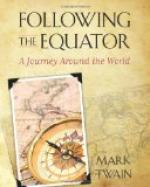With which every salient point is richly fretted—5.
First in the world for purely decorative workmanship—9.
The Taj represents the stage where the architect ends and the jeweler begins—5.
The Taj is entirely of marble and gems—7.
Inlaid with precious stones in lovely patterns of flowers—5.
The inlaid work of flowers done in gems is very brilliant (followed by a most important modification which the reader is sure to read too carelessly)—2.
The vast mausoleum—5.
This marvel of marble—5.
The exquisite enclosure—5.
Inlaid with flowers made of costly gems—5.
A thing of perfect beauty and absolute finish—5.
Those details are correct; the figures which I have placed after them represent quite fairly their individual, values. Then why, as a whole, do they convey a false impression to the reader? It is because the reader—beguiled by, his heated imagination—masses them in the wrong way. The writer would mass the first three figures in the following way, and they would speak the truth
Total—19
But the reader masses them thus—and then they tell a lie—559.
The writer would add all of his twelve numerals together, and then the sum would express the whole truth about the Taj, and the truth only—63.
But the reader—always helped by his imagination—would put the figures in a row one after the other, and get this sum, which would tell him a noble big lie:
559575255555.
You must put in the commas yourself; I have to go on with my work.
The reader will always be sure to put the figures together in that wrong way, and then as surely before him will stand, sparkling in the sun, a gem-crusted Taj tall as the Matterhorn.
I had to visit Niagara fifteen times before I succeeded in getting my imaginary Falls gauged to the actuality and could begin to sanely and wholesomely wonder at them for what they were, not what I had expected them to be. When I first approached them it was with my face lifted toward the sky, for I thought I was going to see an Atlantic ocean pouring down thence over cloud-vexed Himalayan heights, a sea-green wall of water sixty miles front and six miles high, and so, when the toy reality came suddenly into view—that beruiled little wet apron hanging out to dry—the shock was too much for me, and I fell with a dull thud.
Yet slowly, surely, steadily, in the course of my fifteen visits, the proportions adjusted themselves to the facts, and I came at last to realize that a waterfall a hundred and sixty-five feet high and a quarter of a mile wide was an impressive thing. It was not a dipperful to my vanished great vision, but it would answer.




